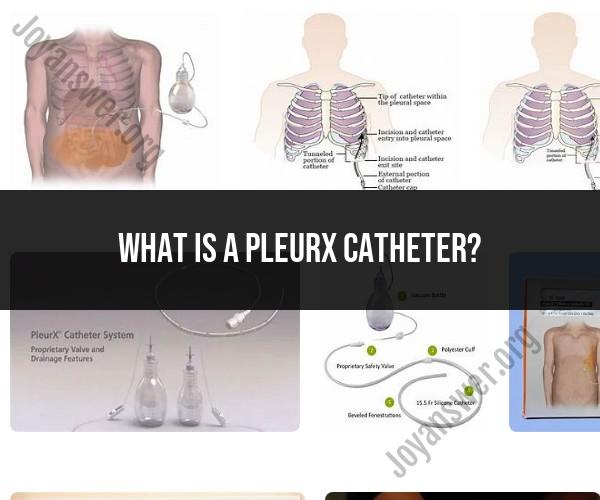What is a PleurX catheter?
A PleurX catheter, also known as a PleurX drain or PleurX system, is a medical device used in the management of recurrent pleural effusions or malignant ascites. Pleural effusion is the accumulation of excess fluid in the pleural cavity, the space between the lungs and the chest wall. Malignant ascites is the accumulation of fluid in the abdominal cavity due to cancer.
The PleurX catheter is a long, thin tube that is inserted through the skin and into the pleural or abdominal cavity to drain and manage the buildup of fluid. It consists of several key components:
Catheter: The catheter is a flexible tube made of medical-grade materials. It is typically placed into the pleural or abdominal cavity through a small incision made in the skin.
Tunneled Exit Site: The catheter exits the body through a tunneled exit site, which helps reduce the risk of infection by providing a barrier between the outside environment and the inside of the body.
One-Way Valve: The catheter is equipped with a one-way valve or flap mechanism that allows fluid to flow out of the body but prevents air and bacteria from entering.
Collection Bottle: At the end of the catheter, there is a collection bottle or bag that collects the drained fluid. The bottle is usually emptied and replaced periodically.
The PleurX catheter system is designed to be a minimally invasive and outpatient solution for patients with recurrent pleural effusions or malignant ascites. It allows for the periodic drainage of excess fluid, which can relieve symptoms such as shortness of breath (in the case of pleural effusion) or abdominal discomfort and distention (in the case of malignant ascites).
Benefits of the PleurX catheter system include:
Improved Quality of Life: Drainage of excess fluid can provide relief from symptoms and improve the patient's overall quality of life.
Reduced Hospitalization: Patients can manage fluid buildup at home, reducing the need for frequent hospitalizations.
Minimally Invasive: The placement of the PleurX catheter is a minimally invasive procedure, typically performed under local anesthesia.
Outpatient Care: The system allows for outpatient management, with patients or caregivers trained to perform drainage as needed.
Reliable Drainage: The one-way valve prevents fluid from re-accumulating rapidly.
It's important to note that the use of a PleurX catheter is typically recommended and managed by healthcare professionals, and patients and caregivers receive training on how to properly use and maintain the system. The catheter can be a valuable tool in the palliative care of patients with these conditions, improving their comfort and overall well-being.
Understanding the PleurX Catheter: Purpose and Function
The PleurX catheter is a thin, flexible tube that is inserted into the pleural space, which is the cavity between the lungs and the chest wall. The PleurX catheter is used to drain fluid from the pleural space, which can accumulate due to a variety of medical conditions, including cancer, heart failure, and pneumonia.
The PleurX catheter is inserted through a small incision in the chest wall. The catheter is then threaded into the pleural space, where it drains the fluid into a collection bag. The catheter can be left in place for several weeks or months, depending on the individual's needs.
Medical Innovation: The Role of the PleurX Catheter in Patient Care
The PleurX catheter is a medical innovation that has revolutionized the treatment of pleural effusions. Before the PleurX catheter was developed, patients with pleural effusions often required hospitalization for repeated thoracenteses, which is a procedure in which a needle is inserted into the pleural space to drain fluid.
The PleurX catheter has made it possible for patients with pleural effusions to be treated at home. This has improved the quality of life for many patients and has also reduced the cost of care.
Empowering Patients: Living with a PleurX Catheter
The PleurX catheter can empower patients to take control of their own health. Patients with a PleurX catheter can learn to drain their own fluid at home, which can give them a sense of independence and control.
Patients with a PleurX catheter can also live active and productive lives. They can participate in most activities that they enjoy, and they can travel without having to worry about finding a healthcare provider who can drain their fluid.
If you are living with a PleurX catheter, there are a few things that you can do to manage your condition effectively:
- Learn how to drain your fluid properly. Your healthcare provider will teach you how to drain your fluid and how to care for your catheter.
- Be aware of the signs and symptoms of infection. If you experience any redness, swelling, or drainage around your catheter site, or if you have a fever, contact your healthcare provider immediately.
- Get regular checkups. Your healthcare provider will need to monitor your condition and make sure that your catheter is functioning properly.
Living with a PleurX catheter can be challenging, but it is possible to live a full and active life. By working with your healthcare provider and following their instructions, you can manage your condition effectively and live a healthy and productive life.












